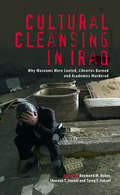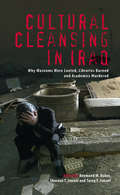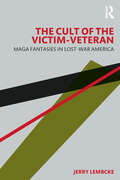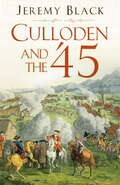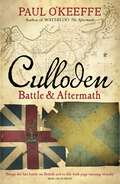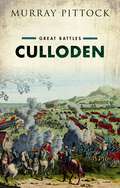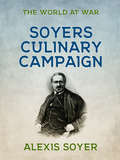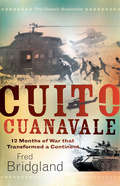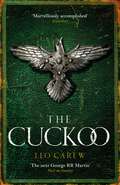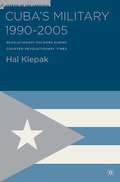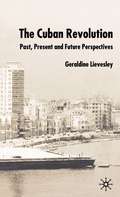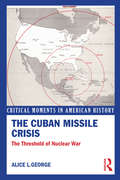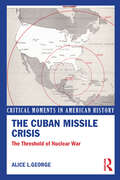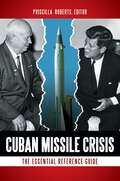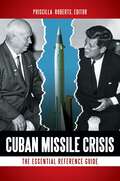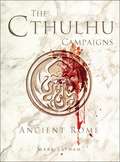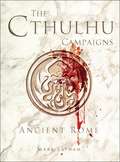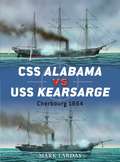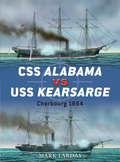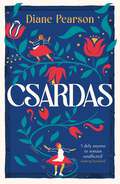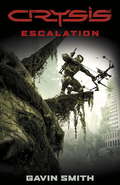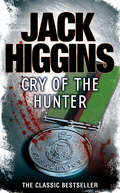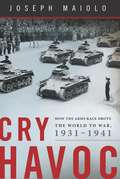- Table View
- List View
Cultural Cleansing in Iraq: Why Museums Were Looted, Libraries Burned and Academics Murdered
by Raymond W. Baker Shereen T. Ismael Tareq Y. IsmaelWhy did the invasion of Iraq result in the destruction of culture and murder of intellectuals? Convention sees accidents of war and poor planning in a campaign to liberate Iraqis. The authors argue instead that the invasion aimed to dismantle the Iraqi state to remake it as a client regime. *BR**BR*Post-invasion chaos created conditions under which the cultural foundations of the state could be undermined. The authors painstakingly document the consequences of the occupiers' wilful inaction and worse, which led to the ravaging of one of the world's oldest recorded cultures. Targeted assassination of over 400 academics, kidnapping and the forced flight of thousands of doctors, lawyers, artists and other intellectuals add up to cultural cleansing.*BR**BR*This book lays to rest claims that the invasion aimed to free an educated population to develop its own culture of democracy.
Cultural Cleansing in Iraq: Why Museums Were Looted, Libraries Burned and Academics Murdered
by Tareq Y. Ismael Raymond W. Baker Shereen T. IsmaelWhy did the invasion of Iraq result in the destruction of culture and murder of intellectuals? Convention sees accidents of war and poor planning in a campaign to liberate Iraqis. The authors argue instead that the invasion aimed to dismantle the Iraqi state to remake it as a client regime. *BR**BR*Post-invasion chaos created conditions under which the cultural foundations of the state could be undermined. The authors painstakingly document the consequences of the occupiers' wilful inaction and worse, which led to the ravaging of one of the world's oldest recorded cultures. Targeted assassination of over 400 academics, kidnapping and the forced flight of thousands of doctors, lawyers, artists and other intellectuals add up to cultural cleansing.*BR**BR*This book lays to rest claims that the invasion aimed to free an educated population to develop its own culture of democracy.
The Cult of the Victim-Veteran: MAGA Fantasies in Lost-war America
by Jerry LembckeThe Cult of the Victim-Veteran explores the pool of American post- Vietnam War angst that rightists began plying in the 1980s. Ronald Reagan’s 1984 proclamation of a new "Morning in America" encoded the war as the moment of the nation’s fall from grace; it was the meme plagiarized by Donald Trump for his "Make America Great Again" (MAGA) slogan. The national funk tapped for right- wing revanchism was psychologized when George H.W. Bush appropriated post- Vietnam syndrome, the diagnostic forerunner to post- traumatic stress disorder (PTSD), to memorialize the military accomplishments in the Persian Gulf War of 1990–1991—we had "kicked the Vietnam Syndrome." America was a victim- nation, its trauma emblemized by PTSD-stricken veterans whose war mission had been lost on the home front, cast aside, even spat on, upon return home. In this book we see the long historical threads woven for MAGA: the twining of traditional and modern ways of knowing that imbues war trauma with political and cultural properties that complicate its diagnostic use; the post- World War I disclosure that many shellshock patients had never been exposed to exploding shells, and the use of wounded- veteran imagery to fan the flames of German fascism; the cultural necessity of reimaging antiwar Vietnam veterans as psychiatric casualties that calls forth a new diagnostic category, PTSD; the derivatizing of PTSD for traumatic brain injury, Agent Orange, and moral injury; and the victim- veteran figure as metaphor for a wounded America, for which MAGA is the remedy.
The Cult of the Victim-Veteran: MAGA Fantasies in Lost-war America
by Jerry LembckeThe Cult of the Victim-Veteran explores the pool of American post- Vietnam War angst that rightists began plying in the 1980s. Ronald Reagan’s 1984 proclamation of a new "Morning in America" encoded the war as the moment of the nation’s fall from grace; it was the meme plagiarized by Donald Trump for his "Make America Great Again" (MAGA) slogan. The national funk tapped for right- wing revanchism was psychologized when George H.W. Bush appropriated post- Vietnam syndrome, the diagnostic forerunner to post- traumatic stress disorder (PTSD), to memorialize the military accomplishments in the Persian Gulf War of 1990–1991—we had "kicked the Vietnam Syndrome." America was a victim- nation, its trauma emblemized by PTSD-stricken veterans whose war mission had been lost on the home front, cast aside, even spat on, upon return home. In this book we see the long historical threads woven for MAGA: the twining of traditional and modern ways of knowing that imbues war trauma with political and cultural properties that complicate its diagnostic use; the post- World War I disclosure that many shellshock patients had never been exposed to exploding shells, and the use of wounded- veteran imagery to fan the flames of German fascism; the cultural necessity of reimaging antiwar Vietnam veterans as psychiatric casualties that calls forth a new diagnostic category, PTSD; the derivatizing of PTSD for traumatic brain injury, Agent Orange, and moral injury; and the victim- veteran figure as metaphor for a wounded America, for which MAGA is the remedy.
Culloden and the '45
by Jeremy BlackThe Jacobite ’45 rebellion was one of the greatest challenges to the eighteenth-century British state, and the Battle of Culloden in which it culminated was certainly one of the most dramatic of the century. Based on extensive archival research, Culloden and the ’45 examines the political and military context of the uprising and highlights the seriousness of the challenge posed by the Jacobites. The result is an illuminating account of an episode often obscured by the perspectives of Stuart romance.
Culloden: Battle & Aftermath
by Paul O'KeeffeCharles Edward Stuart's campaign to seize the British throne on behalf of his exiled father ended with one of the quickest defeats in history: on 16 April 1746, at Culloden, his 5,000-strong Jacobite army was decisively overpowered in under forty minutes. Its brutal repercussions, however, endured for months and years, its legacy for centuries.Paul O'Keeffe follows the Jacobite army, from its initial victories over Hanoverian troops at Prestonpans, Clifton and Falkirk to their calamitous defeat on the field of Culloden. He explores the battle's aftermath which claimed the lives, not only of helpless wounded summarily executed and fugitives cut down by pursuing dragoons, but also of civilians slaughtered by vengeful government patrols as they 'pacified' the Highlands. He chronicles the wild, nationwide celebration greeting news of the government victory, the London stage catering to patriotic fervour with new songs like 'God Save the King', popular musical theatre, and operas by Gluck and Handel. Meanwhile, the public was also treated to the grimmer spectacle of Jacobite prisoners, tried for high treason, paying for their participation on block and gibbet throughout the country. Many others - granted 'the King's mercy' - suffered the lingering fate of forced labour on fever-ridden plantations in the West Indies and Virginia. O'Keeffe reveals the unexpected consequences of the rising - mapping the Scottish Highlands to aid military subjugation would eventually lead to the foundation of the Ordnance Survey - and traces the later careers of the battle's protagonists: the Duke of Cumberland's transformation from idolised national hero to discredited 'butcher'; Charles Edward Stuart's from 'Bonny Prince' to embittered alcoholic invalid. While in the long term the doomed Stuart cause acquired an aura of romanticism, the Jacobite Rising of 1745-46 remains one of the most bloody and divisive conflicts in British domestic history, which resonates to this day.
Culloden: Great Battles (Great Battles)
by Murray PittockThe battle of Culloden lasted less than an hour. The forces involved on both sides were small, even by the standards of the day. And it is arguable that the ultimate fate of the 1745 Jacobite uprising had in fact been sealed ever since the Jacobite retreat from Derby several months before. But for all this, Culloden is a battle with great significance in British history. It was the last pitched battle on the soil of the British Isles to be fought with regular troops on both sides. It came to stand for the final defeat of the Jacobite cause. And it was the last domestic contestation of the Act of Union of 1707, the resolution of which propelled Great Britain to be the dominant world power for the next 150 years. If the battle itself was short, its aftermath was brutal - with the depredations of the Duke of Cumberland followed by a campaign to suppress the clan system and the Highland way of life. And its afterlife in the centuries since has been a fascinating one, pitting British Whig triumphalism against a growing romantic memorialization of the Jacobite cause. On both sides there has long been a tendency to regard the battle as a dramatic clash, between Highlander and Lowlander, Celt and Saxon, Catholic and Protestant, the old and the new. Yet, as this account of the battle and its long cultural afterlife suggests, while viewing Culloden in such a way might be rhetorically compelling, it is not necessarily good history.
Culloden: Great Battles (Great Battles)
by Murray PittockThe battle of Culloden lasted less than an hour. The forces involved on both sides were small, even by the standards of the day. And it is arguable that the ultimate fate of the 1745 Jacobite uprising had in fact been sealed ever since the Jacobite retreat from Derby several months before. But for all this, Culloden is a battle with great significance in British history. It was the last pitched battle on the soil of the British Isles to be fought with regular troops on both sides. It came to stand for the final defeat of the Jacobite cause. And it was the last domestic contestation of the Act of Union of 1707, the resolution of which propelled Great Britain to be the dominant world power for the next 150 years. If the battle itself was short, its aftermath was brutal - with the depredations of the Duke of Cumberland followed by a campaign to suppress the clan system and the Highland way of life. And its afterlife in the centuries since has been a fascinating one, pitting British Whig triumphalism against a growing romantic memorialization of the Jacobite cause. On both sides there has long been a tendency to regard the battle as a dramatic clash, between Highlander and Lowlander, Celt and Saxon, Catholic and Protestant, the old and the new. Yet, as this account of the battle and its long cultural afterlife suggests, while viewing Culloden in such a way might be rhetorically compelling, it is not necessarily good history.
A Culinary Campaign (The World At War)
by Alexis SoyerSoyer's brilliant memoir, a vivid account of the Crimean War and of Soyer's inventions and recipes for feeding armies in the field. He was as important in the Crimea as Florence Nightingale, for his influence on the reform of army feeding enabled wounded soldiers to survive. A modified version of the Soyer stove was still in use in the Gulf War. (Goodreads)
Cuito Cuanavale: 12 Months of War that Transformed a Continent
by Fred BridglandBy September 1987 Angola’s army – supported by Cuba and a billion dollars of arms from the Soviet Union – had assembled massive forces on the Lomba River, 125 km southeast of the Angolan town of Cuito Cuanavale. Their goal? To capture Jamba, headquarters of the rebel group Unita, supported by the South African Defence Force (SADF) in the so-called Border War. The fighting eventually centred around Cuito Cuanavale after a massive battle on the Lomba, where 3 000 SADF soldiers and 8 000 Unita fighters were up against an Angolan–Cuban force of more than 50 000 men. Thousands died in the fighting, vividly and dramatically retold by Bridgland from interviews with scores of men who were on the front line. Thirty years later the question of who won the war still leads to vigorous debate. The final outcome of the war had an impact far beyond the borders of Angola and Namibia. It spelled the end of the last great neo-colonial attempts at African conquest by Cuba and the former Soviet Union and also made possible the dismantling of apartheid in South Africa.
The Cuckoo (Under the Northern Sky)
by Leo CarewLeo Carew's much-lauded UNDER THE NORTHERN SKY trilogy draws to its spellbinding conclusion...Albion continues to be divided by revolt and bloodshed, as alliances collapse and are made anew.Driven obsessively for glory, the upstart Bellamus and his exiled queen Aramilla are marshalling resistance and building a powerful army.Returning to the Hindrunn, Keturah is forced to fend for herself, battling enemies on all sides just when she is most in need of a place of safety.And all the while, the young Black Lord must deal not only with the aftermath of a great betrayal, but the cold shadow of the Kryptea, threatening to destroy everything he has fought for...WHAT REVIEWERS ARE SAYING ABOUT THE BREATHTAKING WORK OF LEO CAREW:'The next George RR Martin' - Mail on Sunday'Imagine Game of Thrones rewritten by John le Carré ... A marvellously accomplished debut' - Guardian'Full of dark conspiracies, larger-than-life characters, and tense battles' - Paul Hoffman, author of The Left Hand of God
Cuba’s Military 1990–2005: Revolutionary Soldiers During Counter-Revolutionary Times (Studies of the Americas)
by H. KlepakThis book is the first examination of the Cuban military in the context of Cuba's political and economic challenges in the aftermath of the collapse of the USSR - and therefore of Soviet economic, political and psychological support. It provides important historical and political contexts of the development and engagement of the military.
The Cuban Revolution: Past, Present and Future
by G. LievesleyThe Cuban Revolution offers a reflective account of what the Revolution has meant to various actors such as the dominant powers, the Third World, fellow revolutionaries, intellectuals and Cuban citizens at different periods in its history. Rather than offer a simple narrative of events, Geraldine Lievesley addresses significant themes with which the Revolution has engaged and the problems that it has encountered.
The Cuban Missile Crisis: The Threshold of Nuclear War (Critical Moments in American History)
by Alice GeorgeFor thirteen days in October of 1962, a truly perilous flirtation with nuclear war developed between the United States and USSR, as the superpowers argued over the installation of Soviet nuclear weapons in Cuba. Launched by rash judgment and concluded through circumspect leadership, the Cuban Missile Crisis acted as a catalyst for change during the Cold War. Resolved through back-channel negotiations, the moment is popularly remembered as the closest the world has ever come to full-scale nuclear war. Using government memoranda, personal letters, and newspaper articles The Cuban Missile Crisis, details the actual events of the political history, while explaining widespread public response. In six concise chapters, Alice George introduces the history of Cold War America and contextualizes its political, social, and cultural legacy. This will be a must-read for anyone looking for an in-depth summary of these important events. For additional resources please visit the companion website at http://www.routledge.com/cw/criticalmoments.
The Cuban Missile Crisis: The Threshold of Nuclear War (Critical Moments in American History)
by Alice GeorgeFor thirteen days in October of 1962, a truly perilous flirtation with nuclear war developed between the United States and USSR, as the superpowers argued over the installation of Soviet nuclear weapons in Cuba. Launched by rash judgment and concluded through circumspect leadership, the Cuban Missile Crisis acted as a catalyst for change during the Cold War. Resolved through back-channel negotiations, the moment is popularly remembered as the closest the world has ever come to full-scale nuclear war. Using government memoranda, personal letters, and newspaper articles The Cuban Missile Crisis, details the actual events of the political history, while explaining widespread public response. In six concise chapters, Alice George introduces the history of Cold War America and contextualizes its political, social, and cultural legacy. This will be a must-read for anyone looking for an in-depth summary of these important events. For additional resources please visit the companion website at http://www.routledge.com/cw/criticalmoments.
Cuban Missile Crisis: The Essential Reference Guide
by Priscilla RobertsDrawing on revealing new research, this richly informative volume is the definitive concise introduction to the crisis that took the world to the brink of nuclear war.Cuban Missile Crisis: The Essential Reference Guide captures the historical context, the minute-by-minute drama, and the profound repercussions of the "Missiles of October" confrontation that brought the very real threat of nuclear attack to the United States' doorstep. Coinciding with the 50th anniversary of the crisis, it takes full advantage of recently opened Soviet archives as well as interviews with key Russian, Cuban, and U.S. officials to explore the event as it played out in Moscow, Havana, Washington, and other locations around the world.Cuban Missile Crisis contains an introductory essay by the author and alphabetically organized reference entries contributed by leading Cold War researchers. The book also includes an exceptionally comprehensive bibliography. Together, these resources give readers everything they need to understand the escalating tensions that led to the crisis as well as the intense diplomacy that resolved it, including new information about the back-channel negotiations between Robert Kennedy and Soviet ambassador Anatoly Dobrynin.
Cuban Missile Crisis: The Essential Reference Guide
by Priscilla RobertsDrawing on revealing new research, this richly informative volume is the definitive concise introduction to the crisis that took the world to the brink of nuclear war.Cuban Missile Crisis: The Essential Reference Guide captures the historical context, the minute-by-minute drama, and the profound repercussions of the "Missiles of October" confrontation that brought the very real threat of nuclear attack to the United States' doorstep. Coinciding with the 50th anniversary of the crisis, it takes full advantage of recently opened Soviet archives as well as interviews with key Russian, Cuban, and U.S. officials to explore the event as it played out in Moscow, Havana, Washington, and other locations around the world.Cuban Missile Crisis contains an introductory essay by the author and alphabetically organized reference entries contributed by leading Cold War researchers. The book also includes an exceptionally comprehensive bibliography. Together, these resources give readers everything they need to understand the escalating tensions that led to the crisis as well as the intense diplomacy that resolved it, including new information about the back-channel negotiations between Robert Kennedy and Soviet ambassador Anatoly Dobrynin.
The Cthulhu Campaigns: Ancient Rome (Dark Osprey)
by Mark Latham Ru-MorRome, the greatest empire the world has ever known, limitless in breadth and power, magnificent in its glory! But something evil, ancient and unknowable gnaws at the heart of the empire. Dark gods, trapped for centuries in thrice-warded tombs, have been disturbed by Roman plunderers. A secret war is fought daily between those who would harness this strange power for themselves, and those who fear it signals the very end of the empire.Across the sea, roused from eternal slumber by a world awash with war, by omens and pagan slaughter, a Great Old One waits for the way to be opened. A cosmic terror that man was not meant to know. Those who know its name tremble, and only the very brave-or very foolish-incant it for their own ends.They whisper it in darkness; they cry it from atop blasted hills; they scream it to the raging oceans. "Cthulhu…†?
The Cthulhu Campaigns: Ancient Rome (Dark Osprey)
by Mark Latham Ru-MorRome, the greatest empire the world has ever known, limitless in breadth and power, magnificent in its glory! But something evil, ancient and unknowable gnaws at the heart of the empire. Dark gods, trapped for centuries in thrice-warded tombs, have been disturbed by Roman plunderers. A secret war is fought daily between those who would harness this strange power for themselves, and those who fear it signals the very end of the empire.Across the sea, roused from eternal slumber by a world awash with war, by omens and pagan slaughter, a Great Old One waits for the way to be opened. A cosmic terror that man was not meant to know. Those who know its name tremble, and only the very brave-or very foolish-incant it for their own ends.They whisper it in darkness; they cry it from atop blasted hills; they scream it to the raging oceans. "Cthulhu…†?
CSS Alabama vs USS Kearsarge: Cherbourg 1864 (Duel #40)
by Peter Dennis Mark LardasThe most successful commerce raider of the Civil War, the CSS Alabama almost single-handedly drove United States merchant shipping from the seas. Her illustrious career saw the capture of 60 merchant ships and two duels with ships of the US Navy. This book gives the complete story of the development of the Confederacy's commerce raiding force and the ships the Union set against them. Compiled from numerous first-hand accounts as well as archeological evidence, it covers the three famous battles of the commerce raiders, CSS Florida vs. USS Wachusett, CSS Alabama vs. USS Hatteras, and CSS Alabama vs. USS Kearsarge, analyzing the strengths and weakness of each of the combatants. While the American Civil War is usually considered a land war, there was plenty of blood in the water.
CSS Alabama vs USS Kearsarge: Cherbourg 1864 (Duel #40)
by Mark LardasThe most successful commerce raider of the Civil War, the CSS Alabama almost single-handedly drove United States merchant shipping from the seas. Her illustrious career saw the capture of 60 merchant ships and two duels with ships of the US Navy. This book gives the complete story of the development of the Confederacy's commerce raiding force and the ships the Union set against them. Compiled from numerous first-hand accounts as well as archeological evidence, it covers the three famous battles of the commerce raiders, CSS Florida vs. USS Wachusett, CSS Alabama vs. USS Hatteras, and CSS Alabama vs. USS Kearsarge, analyzing the strengths and weakness of each of the combatants. While the American Civil War is usually considered a land war, there was plenty of blood in the water.
Csardas
by Diane PearsonThis great bestseller was compared with GONE WITH THE WIND when first published in 1975. CSARDAS – taken from the name of the Hungarian national dance – follows the fortunes of the enchanting Ferenc sisters from their glittering beginnings in aristocratic Hungary, through the traumas of two World Wars. From the dazzling elegance of coming-out balls, feudal estates and a culture steeped in romance, to terror and starvation in the concentration camps – no story could be more dramatic than that of Eva and Amalia Ferenc, whose fate it is to be debutantes when the shot which killed Archduke Franz Ferdinand in Sarajevo plunged Europe into the First World War. Their story is enthralling, tragic, romantic – and absolutely unputdownable.
Crysis: Escalation
by Gavin G. SmithTo tie in to the massive new game CRYSIS 3, coming in February 2013 from EA, Gavin Smith has been signed up to write a selection of connected short stories that will explore and expand the game world. Gavin's futuristic and punchy fiction is a perfect fit for CRYSIS, and this will be a delight for game-players and SF fans alike.With stories covering the fan favourite characters of Prophet, Psycho and Alcatraz, as well as introducing themes, enemies and weapons new to CRYSIS 3, this will be a vital part of the game experience. Punchy and kinetic, this is SF with steel at its heart.
Cry of the Hunter: Cry Of The Hunter And A Prayer For The Dying (The\martin Fallon Novels Ser. #1)
by Jack HigginsReissue of the timeless Higgins classic…
Cry Havoc: How the Arms Race Drove the World to War, 1931-1941
by Joseph MaioloDid the arms race of the 1930s cause the Second World War?In Cry Havoc, historian Joseph Maiolo shows, in rich and fascinating detail, how the deadly game of the arms race was played out in the decade prior to the outbreak of the Second World War. In this exhaustively researched account, he explores how nations reacted to the moves of their rivals, revealing the thinking of those making the key decisions-Hitler, Mussolini, Chamberlain, Stalin, Roosevelt-and the dilemmas of democratic leaders who seemed to be faced with a choice between defending their nations and preserving their democratic way of life. An unparalleled account of an era of extreme political tension, Cry Havoc shows how the interwar arms race shaped the outcome of World War II before the shooting even began.
